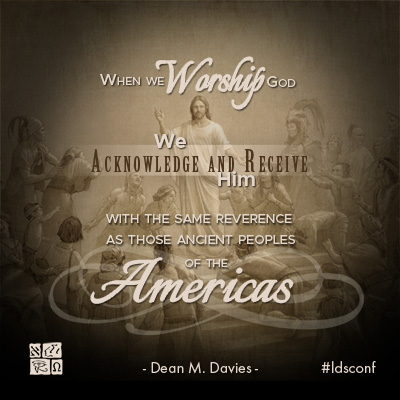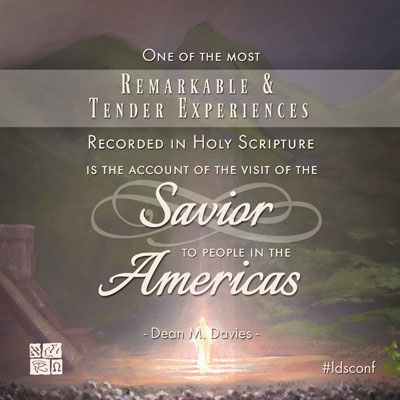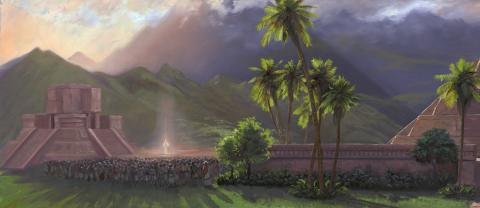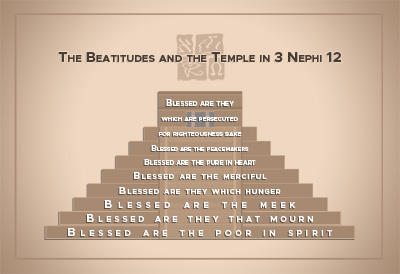You are here
Book of Mormon Central is in the process of migrating to our new Scripture Central website.
We ask for your patience during this transition. Over the coming weeks, all pages of bookofmormoncentral.org will be redirected to their corresponding page on scripturecentral.org, resulting in minimal disruption.
Gospel Doctrine Lesson #37: Whomsoever Will Come, Him Will I Receive

Scripture Block
3 Nephi 8-11
To help class members understand the fulfillment of Samuel’s prophecies and the blessings available to those who come unto the Savior.
Lesson Manual
KnoWhys

Why Did Jesus Christ Compare Himself to a Hen?
3 Nephi 10:4

Why Has 3 Nephi Been Called “the Focal Point, the Supreme Moment” in the Book of Mormon
3 Nephi 11:10

Why Did the People Fall Down at the Feet of Jesus?
3 Nephi 11:17

What is the Purpose of Baptism in the Book of Mormon?
2 Nephi 31:6-7

At Baptism, What Do We Covenant to Do?
Mosiah 18:10

What is the Doctrine of Christ?
2 Nephi 31:21
Articles
Overview
Bokovoy, David E., and John A. Tvedtnes. "Christ in the Old Testament and the Book of Mormon." In Testaments: Links between the Book of Mormon and the Hebrew Bible, 7-23. Toelle, UT: Heritage Press, 2003.
All of the key events, doctrines, and people of the Hebrew Bible point directly to Jesus’ role as the Anointed One of Israel. This is the inspired message proclaimed so passionately by the ancient authors of the Book of Mormon: Jesus is the link between the Book of Mormon and the Hebrew Bible.
Holland, Jeffrey R.. Atonement of Jesus Christ In Encyclopedia of Mormonism, Edited by Daniel H. Ludlow. Vol. 1. New York: Macmillan, 1992.
An encyclopedic entry on the Atonement of Jesus Christ, as explained by Elder Jeffrey R. Holland. The Atonement is the core tenet of Christianity, and is the central focus of the Book of Mormon.
Matthews, Robert J.. "Jesus the Savior in 3 Nephi." In The Book of Mormon: 3 Nephi 9-30, This is My Gospel, edited by Monte S. Nyman and Charles D. Tate, Jr., 25-39. Provo, UT: Religious Studies Center, 1993.
This article discusses Jesus Christ's role in 3 Nephi. Third Nephi offers greater insight into the activity and scope of Jesus' work than that found in the New Testament alone. Matthew discusses the anticipation of Christ's coming, his miraculous appearance in the Americas, the doctrines he taught, and how Jesus Christ's coming is significant for the message of the Book of Mormon and the Gospel of Jesus Christ.
Millet, Robert L., Gary Lee Walker, Jerry C. Giles, Gerald Hansen, Jr., Andrew C. Skinner, Philip J. Schaelling, Daniel C. Peterson, Merril C. Oaks, Tad R. Callister, John Gee et al. Jesus Christ In Encyclopedia of Mormonism, Edited by Daniel H. Ludlow. Vol. 2. New York: Macmillan, 1992.
Encyclopedic entry on Jesus Christ, as he is understood in Mormon theology. Jesus Christ plays a central role in the Book of Mormon, especially when he appears to the Nephites in 3 Nephi.
Nelson, Russell M.. "Jesus the Christ - Our Master and More." In A Book of Mormon Treasury: Gospel Insights from General Authorities and Religious Educators, 19-31. Provo, UT: Religious Studies Center, 2003.
In a thoughtful overview, Elder Russell M. Nelson discusses how Jesus Christ fulfills each of Biblical and Book of Mormon titles attributed to him.
Seely, David R.. Jehovah, Jesus Christ In Encyclopedia of Mormonism, Edited by Daniel H. Ludlow. Vol. 2. New York: Macmillan, 1992.
An Encycopedic entry emphasizing the messianic role of Jesus Christ in Mormonism. Jesus Christ is the Jehovah and God of the Old Testament and was prophesied to come down to earth to redeem his people.
Welch. John W. "Seeing Third Nephi as the Holy of Holies of the Book of Mormon." Journal of the Book of Mormon and Restoration Scripture 19, no. 1 (2010): 36-55.
Third Nephi and its account of the ministry of the resurrected Jesus to the Nephites has long been seen as the pinnacle of the Book of Mormon. This text can also be viewed as the Holy of Holies of the Book of Mormon. Everything in 3 Nephi, especially the ministry of the Savior, echoes themes related to the temple and the presence of the Lord in the Holy of Holies. Themes such as silence, timelessness, unity, awe, and consecration confirm this interpretation.
Hyde, Paul Nolan. A Comprehensive Commentary of the Book of 3 Nephi. Orem, UT: Parrish Press, 2015.
Kimball, Linda Hoffman. "The Coming of Christ." In The Reader's Book of Mormon: The Coming of Christ: Helaman 5 – 3 Nephi, edited by Robert A. Rees and Eugene England, vii-xxix. Salt Lake City: Signature Books, 2008.
3 Nephi 8
Ball, Russell H. "An Hypothesis concerning the Three Days of Darkness among the Nephites." Journal of Book of Mormon Studies 2, no. 1 (1993): 107-23.
Aspects of the three days of darkness following the three-hour period of intense destruction described principally in 3 Nephi are discussed, including: (1) the strange absence of rain among the destructive mechanisms described; (2) the source of the intense lightning, which seems to be unaccompanied by rain; (3) a mechanism to account for the inundation of the cities of Onihah, Mocum, and Jerusalem, which were not among the cities which “sunk in the depths of the sea”; and (4) the absence in the histories of contemporary European and Asiatic civilizations of corresponding events, which are repeatedly characterized in 3 Nephi as affecting “the face of the whole earth.”
Benson, Alvin K.. "Geological Upheaval and Darkness in 3 Nephi 8-10." In The Book of Mormon: 3 Nephi 9-30, This is My Gospel, edited by Monte S. Nyman and Charles D. Tate, Jr., 59-72. Provo, UT: Religious Studies Center, 1993.
Both the prophecies on the birth of Christ and the death of Christ were fulfilled in great detail. The destruction indeed altered the whole land of the Nephites. This article discusses the nature of the destruction and possibilities for the upheaval of the land, as well as the vapor of darkness.
Chadwick, Jeffrey R.. "Dating the Death of Jesus Christ." BYU Studies Quarterly 54, no. 4 (2015): 135-191.
This article puts forth arguments to determine the dating of Jesus Christ's birth and death, in response to a BYU Studies article from 2010.
Cummings, David B. "Three Days and Three Nights: Reassessing Jesus's Entombment." Journal of Book of Mormon Studies 16, no. 1 (2007): 56-63, 86.
The Bible does not explicitly state on which day of the week the Savior was crucified, and the passages describing the length of time he spent in the tomb can be interpreted in multiple ways. Depending on how days were measured and on what Sabbath the day of preparation preceded—whether the weekly Sabbath or the Passover Sabbath—the crucifixion could plausibly have occurred on Wednesday, Thursday, or Friday. The Bible and history have not been able to determine on which day of the week the crucifixion occurred, but the Book of Mormon gives additional information to establish the day. Based on a comparison of the passages in the two texts and an examination of time differences between the two hemispheres, Thursday appears to be the most plausible solution.
Gee, John. "Another Note on the Three Days of Darkness." In Pressing Forward with the Book of Mormon: The FARMS Updates of the 1990s, edited by John W. Welch and Melvin J. Thorne, 219-227. Provo, UT: FARMS, 1999.
An Egyptian stele that documents a violent volcanic eruption finds many parallels with the description found in the Book of Mormon of the destruction in 3 Nephi. John Gee asserts that this may be evidence for volcanic activity causing the great destruction in the land.
Grover, Jr., Jerry D.. "Earthquake and Volcano Interaction." In Geology of the Book of Mormon, 137-138. Vineyard, UT: n.p., 2014.
Jerry Grover documents how earthquakes and volcanoes can often occurr together in cataclysmic events, accounting for both the darkness and the land upheaval in 3 Nephi.
Grover, Jr., Jerry D.. "Identification of a Regional Earthquake Fault Zone." In Geology of the Book of Mormon, 139-148. Vineyard, UT: n.p., 2014.
This detailed analysis provides criteria for identifying what kind of earthquake may have destroyed the Nephite lands, and what fault zone it may be located in. He determines that the Veracruz fault segment satisfies all of the necessary conditions given in the Book of Mormon as the primary earthquake fault system.
Grover, Jr., Jerry D.. "Destruction Timeline." In Geology of the Book of Mormon, 73-76. Vineyard, UT: n.p., 2014.
Some of the destructive events recorded in 3 Nephi are dependent on seasonality and the timeline of the events. Grover proposes several possible dates for Christ's death, and thus the destruction found in 3 Nephi.
Jordan, Benjamin R. "Investigating New World Volcanism at the Time of Christ's Death." Insights 23, no. 6 (2003).
This article proposes a methodology for further research on the potential volcanic activity at the time of Christ's death. The author suggests that the next step in research, is to take sediment core samples from lakes in Mesoamerica to find ash layers that correspond to the dating proposed in the Book of Mormon.
Jordan, Benjamin R. "Volcanic Destruction in the Book of Mormon: Possible Evidence from Ice Cores." Journal of Book of Mormon Studies 12, no. 1 (2003): 78-87, 118-119.
Third Nephi 8 preserves a written account of a natural disaster at the time of Christ’s death that many assume to have been caused by volcanic activity. In a modernday science quest, the author examines research done on glacial ice cores from Greenland and Antarctica. Ice-core records can reveal volcanic gases and ashes that are carried throughout the world—the gases are detected by measuring the acidity of the ice at various layers. Many factors influence the findings and the proposed datings of the volcanic events. The ice-core records offer some evidence, though not conclusive, of a volcanic eruption around the time of Christ’s death.
Kowallis, Bart J. "In the Thirty and Fourth Year: A Geologist’s View of the Great Destruction in 3 Nephi." BYU Studies Quarterly 37, no. 3 (1997): 136-190.
Geological studies and eyewitness accounts of volcanic activity show the likelihood that the massive destruction reported in 3 Nephi was caused by an explosive volcanic eruption.
Tvedtnes, John A. "Historic Parallels to the Destruction at the Time of the Crucifixion." Journal of Book of Mormon Studies 3, no. 1 (1994): 170-186.
To the nonbeliever, the wide variety of destructive forces unleashed in the New World at the time of Christ’s crucifixion seems preposterous or, at the very least, unscientific. The account in 3 Nephi 8–9 mentions the simultaneous occurrence of earthquake, fire, strong winds, extensive flooding, the complete burial of cities, and thick darkness. An examination of known great natural disasters in historical times reveals that the Book of Mormon in no way exaggerates. All of the destructive forces mentioned in 3 Nephi 8–9 can be readily explained in terms of the tectonic forces that result from the encounter of the plates on which the continents and the oceans lie. The complex variety of destructive forces that we normally consider to be separate phenomena of nature is, in reality, strong evidence for the historicity of the Book of Mormon account.
Unknown. "Out of the Dust: When the Day Turned to Night." Journal of Book of Mormon Studies 10, no. 2 (2001): 66-67, 71.
The timing of volcanic eruptions in the Veracruz area, where many scholars suggest the Book of Mormon may have taken place, is contemporary with events recorded in the Book of Mormon, thus providing further evidence of the authenticity of that book.
Rappleye, Neal. "'The Great and Terrible Judgments of the Lord': Destruction and Disaster in 3 Nephi and the Geology of Mesoamerica." Interpreter: A Journal of Mormon Scripture 15 (2015): 143-157.
Over recent decades, several Latter-day Saint scholars and scientists have offered analysis and comparison to geologic events and the destruction recorded in 3 Nephi 8-9. Jerry Grover makes an important contribution to this literature as he provides background on geologic processes and phenomena, details the geologic features of the Tehuantepec region (Mesoamerica), and applies this information to not only the description of 3 Nephi 8-9, but other incidents in the Book of Mormon likely connected to geologic events. In doing so, Grover yields new insights into the narratives he examines, and adds clarity to geographic details that have been subject to varying interpretations.
Roper, Matthew. "A Note on Volcanism and the Book of Mormon." Insights 29, no. 4 (2009).
Matthew Roper notes that a side effect of large volcanic eruptions is lessened agricultural productivity. The crops are destroyed and the soil is damaged so that it is difficult for crops to grow. This may be connected to Mormon's statement that it took 59 years for the land to be prosperous again.
3 Nephi 9
Blanch, Mae. "Repentance: The Gift of Love." In The Book of Mormon: 3 Nephi 9-30, This is My Gospel, edited by Monte S. Nyman and Charles D. Tate, Jr., 73-87. Provo, UT: Religious Studies Center, 1993.
Blanch discusses the beautiful and powerful message of repentance found in 3 Nephi when the Savior's voice is heard throughout the land. He laments how he would have gathered them as a hen if they would only repent.
Jordan, Benjamin R.. "'Many Great and Notable Cities Were Sunk': Liquefaction in the Book of Mormon." BYU Studies Quarterly 38, no. 3 (1999): 119-122.
In this article, the author suggests an alternate cause for the "many great and notable cities [being] sunk" in 3 Nephi.
Nyman, Monte S.. "The Designations Jesus Gives Himself in 3 Nephi." In The Book of Mormon: 3 Nephi 9-30, This is My Gospel, edited by Monte S. Nyman and Charles D. Tate, Jr., 41-58. Provo, UT: Religious Studies Center, 1993.
After the destruction in 3 Nephi, the voice of Christ is heard. Christ cries repentance to his people and declares who he is, using various names and titles. This article discusses the significance of each of those names.
Sorenson, John L. "The Submergence of the City of Jerusalem in the Land of Nephi." Insights 22, no. 4 (2002).
Based off the account of destruction in 3 Nephi 9, Sorenson proposes that the Book of Mormon city of Jerusalem is located at the south of Lake Atitlan in Guatemala.
3 Nephi 10
Brandt, Edward J.. "The Name Jesus Christ Revealed to the Nephites." In The Book of Mormon: Second Nephi, The Doctrinal Structure, edited by Monte S. Nyman and Charles D. Tate, Jr., 201-206. Provo, UT: Religious Studies Center, 1989.
This article discusses the importance of the name of Jesus Christ throughout the Book of Mormon. This importance is emphasized in 3 Nephi when Christ names his church after himself.
Brown, S. Kent. "When Did Jesus Visit the Americas?" In From Jerusalem to Zarahemla: Literary and Historical Studies of the Book of Mormon, 146-156. Provo, UT: Religious Studies Center, 1998.
Conflicting views exist about when Jesus appeared to his New World disciples. Observations from the text suggest that he mercifully waited for the people to recover from the destruction that attended his crucifixion.
3 Nephi 11
Hawkins, Carl S.. Baptism In Encyclopedia of Mormonism, Edited by Daniel H. Ludlow. Vol. 1. New York: Macmillan, 1992.
Encyclopedic entry on Baptism in Mormon Theology.
Jones, Clifford P. "The Great and Marvelous Change: An Alternate Interpretation." Journal of the Book of Mormon and Restoration Scripture 19, no. 2 (2010): 50-63.
The customary interpretation of 3 Nephi 11:1 has been that those around the temple in Bountiful were showing one another the “great and marvelous change” that had taken place in the land as a result of the physical destruction attending the crucifixion of Jesus Christ. However, Jones argues that the phrase “the great and marvelous change” used here refers to the infinite Atonement itself—the singular (then-recent) event that fulfilled the law of Moses and changed once and for all the eternal prospects for all of God's children. By examining the context in which this scripture appears and by interpreting related verses—especially those which emphasize the way in which most revelation is received—Jones argues that the atonement of Jesus Christ and the individuals’ subsequent change of heart would have been the main topic of their discussion and would therefore be an appropriate understanding of the scripture.
Reynolds, Noel B.. "The Gospel of Jesus Christ as Taught by the Nephite Prophets." BYU Studies Quarterly 31, no. 3 (1991): 31-50.
This article details the tenets of the Gospel of Jesus Christ as found in the Book of Mormon. The article draws much from what Christ layed out for the Nephites in 3 Nephi.
Reynold, Noel B. "The True Points of My Doctrine." Journal of Book of Mormon Studies 5, no. 2 (1992): 26-56.
In a 1991 BYU Studies article, I identified and analyzed three core Book of Mormon passages in which the gospel or doctrine of Jesus Christ is defined. Each of these passages presents the gospel as a six-point formula or message about what men must do if they will be saved.
Reynolds, Noel B.. "Understanding Christian Baptism through the Book of Mormon." BYU Studies Quarterly 51, no. 2 (2012): 3-37.
Early Christianity saw a wide proliferation of theories and practices concerning baptism, and now many Christians, including Mormons, commonly understand it as a means to repent and wash away one's sins. But the Book of Mormon prophets taught that baptism is a covenant and a witnessing to God that one has already repented and commits to follow Jesus Christ, and that sins are remitted by the Holy Ghost.
Welch, John W.. "The Sermon at the Temple." In Reexploring the Book of Mormon, edited by John W. Welch, 253-256. Provo, UT: FARMS, 1992.
This article shows how the sermon that Christ gave to the Nephites, and the sermon that Christ gave to Israel in his mortal ministry, is connected to the temple and sacred covenants.
Wilson, Jerry A.. Baptismal Covenant In Encyclopedia of Mormonism, Edited by Daniel H. Ludlow. Vol. 1. New York: Macmillan, 1992.
Encyclopedic entry on the Baptismal Covenant as found in the Book of Mormon.
Wilson, Jerry A.. Baptismal Prayer In Encyclopedia of Mormonism, Edited by Daniel H. Ludlow. Vol. 1. New York: Macmillan, 1992.
Encyclopedic entry on the Baptismal Prayer as found in 3 Nephi when the Savior visits America.
Reynolds, George. "'Infant Baptism and the Sacrament'." Improvement Era 4, no. 4 (1901): 247-252.
Roberts, B.H.. "Christ in the Book of Mormon: His Appearance on the American Continent." Improvement Era 27, no. 3 (1924): 188-192.
Additional Lesson Guides
LDS Living Gospel Doctrine Lesson #37
RSC Gospel Doctrine Lesson #37
GospelDoctrine.com 3 Nephi 8, 3 Nephi 9, 3 Nephi 10, 3 Nephi 11
Feast Upon the Word Gospel Doctrine Lesson #37























